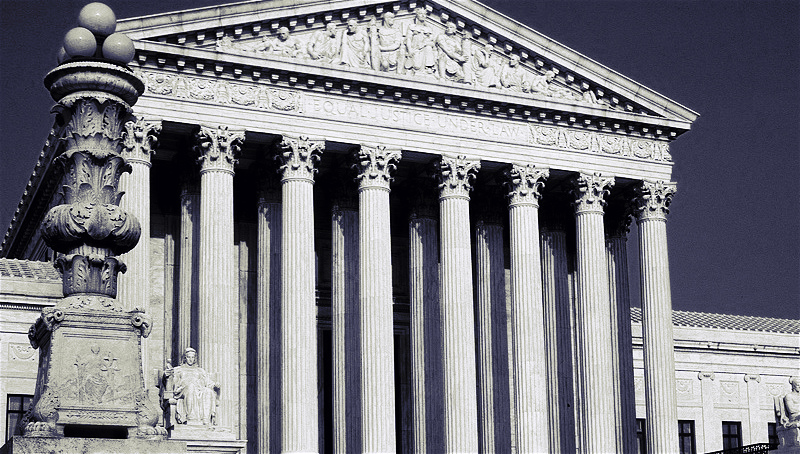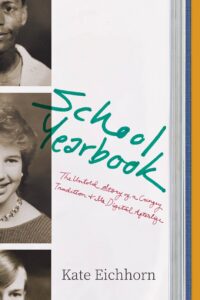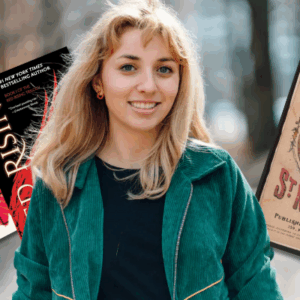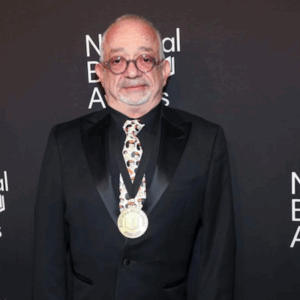
On the Sweeping Supreme Court Decision That Led to Widespread High School Censorship
Kate Eichhorn Explores the Systematic Erasure of Political Speech in Yearbooks
Since the late 19th century, school yearbooks have been a ubiquitous and mostly unchanging element of American school life. Decade after decade, they deliver a predictable mix of class, club, and team photos, cheesy graphics, and cringey comments. But the most consistent feature of yearbooks may be what they don’t include—references to political upheaval or resistance movements.
As public schools across the United States face heightened censorship and the threat of funding losses for noncompliance, school yearbooks remind us that there is nothing new about political censorship in schools. A few rare examples also reveal that there some students and educators always find ways to circumvent expectations and policies.
Before and After the Hazelwood Ruling
In the United States, the censorship of school publications is nearly blamed on a 1988 Supreme Court ruling, though the ruling simply codified a practice that was already well established.
In 1983, the principal of Missouri’s Hazelwood East High School removed two pages from the school’s student newspaper, because they featured articles on the topics of teen pregnancy and the impact of parents’ divorce on children. Cathy Kuhlmeier, one of the student editors, decided to fight back, arguing that the principal’s decision met conditions for restraint of the press. While a federal district judge ruled against Kuhlmeier, the Eighth Circuit Court of Appeals ruled in her favor. In 1988, five years after her case was filed, the Supreme Court ultimately ruled 5-3 that public school officials do have the power to censor school newspapers, plays, and other “school-sponsored expressive activities.”
In many respects, Hazelwood simply offered a legal precedent to back up the censorship of school journalists that was already pervasive.
Since 1988, Hazelwood has continued to cast a chill on student journalism across the United States, empowering schools to not only to censor references and depictions of pregnant teens and teen parents but any image, article, or even reference to an event or ideology that seems to be at odds with the school or school district’s policies and positions. For example, since 2020, Hazelwood has consistently been cited to justify the censorship of mere references to Black Lives Matter and student-led protests against anti-gay and anti-transgender legislation in student publications. But it would be misleading to assume Hazelwood is solely responsible for the censorship of school newspapers and yearbooks.
The Hazelwood ruling made it nearly impossible for student journalists to rely on laws that protect other US journalists, but in many respects, Hazelwood simply offered a legal precedent to back up the censorship of school journalists that was already pervasive.
Reading Resistance, Between the Lines
From the Civil Rights movement to the more recent struggle for transgender rights, schools have frequently emerged as the sites where shifting cultural norms and laws are first put to the test. Yet, if you set out to write a history of American culture based on yearbooks alone, however, the most significant political events and movements of the past century would likely never make an appearance.
The silence of school yearbooks on race politics and the fight for racial equality first struck me when I started to look for documentation on the Civil Rights movement in U.S. yearbooks from the 1960s. A survey of hundreds of yearbooks revealed that even those produced at schools in communities at the center of the fight for racial equality rarely touch upon racial politics. One notable exception I discovered was a junior high school yearbook from Harlem’s Wadleigh High School.
Originally a high school serving girls in Upper Manhattan, in 1956, Wadleigh was restructured as a coeducational junior high. By the mid-1960s, the school, located in the center of Harlem, was among the few schools in the United States to publish a yearbook directly engaged with the civil rights and Black Power discourses of the era.
Some of the articles published in The Wadleigh Way simply reported on events taking place at the school, including a visit by William Booth, a civil rights lawyer and the New York State president of the NAACP. But The Wadleigh Way also went out of its way to include articles with students’ personal opinions on race-related politics.
That students at Wadleigh seemed to be able to express their opinions on race politics and issues such as segregation—and were even encouraged to do so—was not a coincidence. By the late 1960s, the school’s leadership had adopted an increasingly political stance. Principal Perry Spiro opened the 1967 issue of The Wadleigh Way by directly addressing racism: “So long as men decide, consciously or otherwise, that all whites, all Negroes, all Jews, all Irish, all Italians, etc. can be identified by certain unique personality traits or behavior, they will remain the prisoners of prejudice.” He goes on to urge his students to move beyond such prejudicial thinking. It is rare for a principal to broach such concerns in a yearbook message, but even rarer for students to adopt a yearbook as a platform to reflect on the injustices. they were witnessing in their community, city, and nation and to embrace the yearbook as a space for speculating on a future world without violence and racism as part of everyday life.
In 1969, the year of the historic moon landing, The Wadleigh Way adopted a space travel theme for its yearbook, as did many schools nationwide, but students at this Harlem school weren’t just interested in celebrating NASA’s accomplishments. Influenced by the potential of space exploration and the rhetoric, aesthetics, and politics of the Black Power movement prevalent at the time, the 1969 yearbook featured texts and images both firmly grounded in the students’ everyday lives and reflecting on future worlds. Among other notable contributions that year was eighth grader Lynn Majors’s short story “2001.” In it, she describes being the only female on a journey to Venus, where she meets a species “similar to the human race” yet one in which “everyone is equal.” The short story also presents a dilemma: Many “Venetians” want to join the humans on their journey back to Earth, but would that be to their benefit, or would it “throw them into our pit of war?”
Other contributions to the 1969 Wadleigh Way focused on concerns much closer to home. In a short opinion piece, the eighth grader Rena Ullah wrote: “If I were to protest, it would be about the trips to the moon. I think that the trips to the moon are unnecessary because the money the government spends is uncalled for. The government spends can be used for building houses, welfare and other things that this city needs.” In a poem titled “Hunger in the Ghetto,” the eighth grader Herbert McKee asks, “Who’s known hunger in the ghetto?” In response, he reflects: “I’ve known hunger in the Ghetto. / Not a hunger for food or for drink, /But a hunger to be a man and have a private place to think. / A place to sit and decifer [sic] my white brother, / and ask myself why can’t we love each other?”
Even the design of The Wadleigh Way seemed to allude to the politics of the era. The table of contents page, for example, included a word cloud with the words Black and power, cut and paste together in the style of a manifesto. While the students at Wadleigh may have been free to directly engage with the politics of the era, they were clear outliers.
At John W. Ligon High School in Raleigh, North Carolina—a school that didn’t desegregate until 1971—the closest the 1969 yearbook got to engaging the racial tensions of the era was the inclusion of a two-page memorial to Dr. Martin Luther King Jr., who had been assassinated the previous year.
Even at Central High School in New Jersey, where many of the school’s students likely witnessed or were impacted by the Newark riots of 1967—four days of race-driven conflict that turned the National Guard on local residents and left twenty-six people dead—the school yearbook offers at best a muted response to the community’s and nation’s ongoing racial tensions. In the 1969 edition of the school’s Cog ’n’ Pen, the only explicit mention of race appears in the yearbook’s dedication: “We the class of 1969, in an effort to express ourselves and rededicate ourselves; dedicate our yearbook to Black Americans.” But even this dedication is followed by a disclaimer. “Our dedication,” the editors add, “is not an act of protest, it is an act of self esteem haughtiness.” Whether the yearbook editors were asked by school leadership to include this disclaimer is unknown, but it seems likely.
At first glance, the yearbook produced nearby at Newark’s Arts High School appears just as circumspect as the Cog ’n’ Pen. The only reference to Black culture or politics in the school’s 1970 yearbook is a single photograph of the Black Culture Club, which appears on a two-page spread alongside photographs of the school’s band and bowling club. A short text next to the photograph explains that the purpose of the club, which was introduced the previous year as the African Culture Club, is to “explore the place of the black man in America and to establish his relationship with his African heritage” through participation in “programs about music, dances, literature and art as well as films, records and slides.” But hidden among the short statements accompanying graduating seniors’ photos, a different story about the student body’s connection Black culture and politics is also hidden in plain sight.
In the 1970 yearbook, several seniors list among their likes not only the names of close friends and favorite sports and musicians but also the names of Black writers, including local poet and activist Amiri Baraka. One senior’s profile went a step further.
In 1968, in the wake of bearing witness to the Newark riots, Atno Newman Smith joined the Panther Youth along with his brother Roger, who attended another Newark high school. In his 1970 yearbook, Smith unsurprisingly doesn’t list the Panther Youth as one of his pastimes (nor could he have since, at the time, the Panthers were viewed as a threat to national security), but for anyone reading between the lines, the senior statement accompanying his photograph leaves little doubt about his political affiliation. Packed into his short senior statement are references to Black Panthers’ founder Huey Newton; Black Rage, a 1968 book by Price Cobbs and William Grier that explored the long-term psychological, social, and economic impacts of slavery; Malcolm X, a 1969 collection of essays on Malcolm X; and Afro-6, a 1969 action novel by Frank Lopez about a successful takedown of New York’s rich elite by a Harvard-educated Black Latino and a Jewish academic.
The Legacy of Censorship in Documentation of School Life
More than five decades later, surprisingly little has changed for many American high school students interested in confronting racial politics or anti-racist activism, at least in their high school yearbooks. In 2021, following George Floyd’s murder in spring 2020 and the Black Lives Matter protests that followed, at least some yearbooks at least attempted to include coverage of the protests—not all did so without backlash.
At Bigelow High School in Arkansas, yearbook staff decided to include a full-page timeline of national and global events that had shaped students’ lives in 2020 to 2021. Among other events, they included mentions of President Trump’s claims that the 2020 presidential election was rigged, of the then-ongoing COVID-19 pandemic, and of George Floyd’s murder and the Black Lives Matter protests that followed. Given that all these events had been widely reported on by news media globally, the decision to include them on the timeline shouldn’t have been controversial. Still, some members of the Bigelow High School community argued that their mere inclusion constituted a form of bias.
In response to the alleged “community backlash,” the timeline pages were ripped out of all the Bigelow yearbooks, which had already been printed and delivered to the school. In a letter to the superintendent, the Student Press Law Center (SPLC) executive director Hadar Harris cast the incident as a clear case of censorship: “It is painfully clear that you did not remove these pages from the yearbook for any legally justifiable reason. In fact, even the legally dubious reason you gave about the so-called ‘community backlash’ failed to hold up under closer scrutiny.” Hadar added, “Having Bigelow High School students witness government officials physically ripping otherwise lawful pages from the student yearbook is…a lousy civics lesson.”
Since 2020, several other US high school journalists have faced similar challenges for simply mentioning local, national, and world events in the pages of their yearbooks. For example, when the principal of West Broward High School in Pembroke Pines, Florida, discovered a full-page spread on Black Lives Matter in his school’s 2020–21 yearbook, he paused the book’s distribution. In that case, school officials argued that, by mentioning Black Lives Matter without mentioning “all lives matter” or “blue lives matter,” the student journalists had failed to engage in objective journalism, though, since Hazelwood, student journalists haven’t been protected, even when engaging objective journalism.
It seems likely that… school yearbooks will continue to big on hair, but not necessarily on documenting the events and resistance movements that shape young people’s lives in and beyond their schools.
The politics of race and anti-racist movements aren’t alone in being placed under erasure in U.S. school yearbooks. Survey thousands of school yearbooks (this is now easily done since over a half a million yearbooks are available on open-access sites such as the Internet Archive and behind paywalls on sites like Ancestry) and you’ll quickly realize that most major political events and resistance movements are just as unlikely to ever be mentioned.
Consider the Women’s Liberation movement in the late 1960s to 1970s. Although it transformed girls’ access to education—and finally resulted in both girls and their female teachers being able to wear pants to school—school yearbooks from the period contain few references to Women’s Lib or feminism. Even the rare reference found in the 1973 edition of The Watchtower, the yearbook published by Rock Island Public High School in Illinois, only seemed to slip in because a small group of girls at the school established an official women’s liberation club at the school from 1973 to 1974. Once the club disappeared in 1975, however, so did any references to the struggle for gender rights that was still remaking American society at the time.
Unsurprisingly, references to gay rights are even more difficult to find in school yearbooks. In fact, until the early 2000s—and, then, only due to the formation of gay-straight alliance (GSA) organizations—school yearbooks remained openly homophobic and gender normative but seemingly oblivious to the gay rights and queer rights movements that unfolded in the late twentieth century.
In school yearbooks, the rule of thumb is simple: if you can turn your identity or movement into a sanctioned school club, it will probably get at least a half page in the yearbook. If you can’t, in most official accounts of school life, you simply won’t be counted.
*
Sadly, despite the fact that yearbooks are meant to represent the complete story of a year in the life of a school and provide a context to help students develop journalism skills, which includes writing objectively about current events, yearbook editors and staff are routinely asked to make cuts to their yearbooks based on deeply biased guidance from school administrators. Since the 1988 Hazelwood ruling provided schools and school boards with the legal grounds to contest student appeals, student journalists have not had the law on their side, although efforts to protect them continue.
As of late 2024, eighteen US states had passed New Voices laws, which seek to override the Hazelwood ruling by ensuring that “student media can only be censored if that media is libelous or slanderous, contains an unwarranted invasion of privacy, violates state or federal law, or incites students to disrupt the orderly operation of a school.” The laws further prohibit “retaliation against advisers who refuse to censor student journalists.” Currently, eight other U.S. states have introduced bills aimed at restoring and protecting student press freedom.
While the New Voices campaign offers one reason to hope that more student journalists will be able to objectively document what is happening in their schools, the current climate in U.S. education suggests that censorship is likely to persist. In a political climate where even the use of certain words, including gender and diversity, has come to be viewed as tantamount to promoting specific ideologies on gender and race, and where K-12 schools are increasingly vulnerable to funding blockages for non-compliance, it seems almost certain that student journalists will face an uphill battle as they attempt to diversify representation. As they have been for over a century, it seems likely that, at least under the current administration, school yearbooks will continue to big on hair, but not necessarily on documenting the events and resistance movements that shape young people’s lives in and beyond their schools.
__________________________________

From School Yearbook: The Untold Story of a Cringey Tradition and Its Digital Afterlife by Kate Eichhorn. Copyright © 2025. Available from University of Chicago Press.
Kate Eichhorn
Kate Eichhorn is a media historian and cultural critic; her books on media, memory, and youth cultures include The End of Forgetting and School Yearbook: The Untold Story of a Cringey Tradition and Its Digital Afterlife, forthcoming from the University of Chicago Press in November.












